Apr 7, 2016
In the October 1925 meeting of The Mount Sinai Hospital Board of Trustees minutes, the Trustees discuss a request from the House Staff for the Hospital to build a golf cage on the roof of the staff housing. The Trustees agreed but wanted the Medical Board to approve it and to decide “whether it might not be detrimental to the care of the patients to furnish this additional amusement to the house staff.” The project was eventually approved by the Medical Board, but it is unclear if the golf cage was ever built.
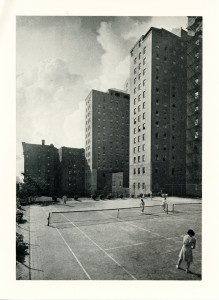
The Mount Sinai tennis courts, at Fifth Avenue and 99th Street.
This request was part of a trend for the active House Staff. In 1923, the Board had approved funds to build a tennis court for the Mount Sinai medical staff and School of Nursing students. It was erected on the corner of Fifth Avenue and 99th Street. Sadly, it was closed in 1948 to make way for the Klingenstein Pavilion.
In a 1988 interview, Gus Burton, a Radiology Technician, discusses what it was like when he was hired in 1948. He says that he was the second Black man hired at Mount Sinai in a non‑janitorial position. He mentioned these tennis courts:
Q. Why did you come here? Tell me a little about why Mount Sinai.
Burton: It’s very interesting. Back in those days the buses that ran along Fifth Avenue were owned by a company called the Fifth Avenue Bus Company. They had double deckers. The top deck was so that you could ride the bus for a nickel. At the time I was a student at NYU and sometimes I would take the bus down, because the classes were at Washington Square. It was almost like a bus tour going down Fifth Avenue, seeing all the different places, and I saw the Hospital. I wasn’t impressed with the hospital so much, but where Klingenstein is there used to be tennis courts. At that time I was an avid tennis player, and I could see these people playing tennis. I thought it was very, very interesting, because I had found that there weren’t many places to play tennis in New York and here these people were running around playing tennis. Eventually, one day I was coming back home and I got off the bus. It was approaching the end of the semester and I said I need to find some kind of work for the summer. It was raining pretty hard, so I ran under the canopy that they had by the [Guggenheim] Pavilion. So I said, let me just check in here and see what’s going on. In those days, they didn’t really have what you call a personnel office. I guess they called it an employment office. They had about one or two clerks and the person who ran it, a Mr. Kerr (?). I just walked in and asked them if they had any jobs available. Said Mr. Kerr, “we may have some available in the radiology department. We’ll refer you to the person there who is looking for somebody and see what happens.” …..
Well, I found out after I started working here that those tennis courts were for the professional staff, the doctors and the nurses, and they were the ones I had seen playing on them. It so happened that one of the radiologists on our staff was an avid tennis player, he used to play out there frequently so I was able to get with him and I did get a chance to play on those tennis courts.
For more information about the Burton interview, or sports at Mount Sinai, please contact the Mount Sinai Archives.
Mar 25, 2016
The Mount Sinai Archives continues to process a recently received collection of records and photographs that document the history of the Beth Israel Medical Center, today’s Mount Sinai Beth Israel. Among the many fascinating documents in this collection are a collection of photographs and news clippings that document the life of Charles H. Silver, who served for 35 years as the Chairman of Beth Israel’s Board of Trustees. The child of an impoverished Romanian Jewish immigrant family on the Lower East Side, Silver left school at age fifteen to become an office boy at the American Woolen Company, where he worked his way up the sales ranks and eventually retired as Vice President and Director.
Alongside his role as a hospital philanthropist, Silver was active in interfaith relations and worked to strengthen the relationship between New York City’s Jewish and Catholic communities, becoming a close confidante of Francis Cardinal Spellman, Archbishop of New York, and his successor Terence Cardinal Cooke. In 1948 Silver served as chairman of the first Alfred E. Smith Memorial Foundation Dinner, which raises funds for Catholic charities. In gratitude for his exceptional fundraising efforts, the proceeds of which would help support New York City’s Catholic hospitals, Cardinal Spellman presented him at the dinner with a surprise donation to Beth Israel. The Al Smith Dinner remains an important event in national politics, as it is traditionally the last event at which the two major-party candidates for President of the United States share a stage before the election.
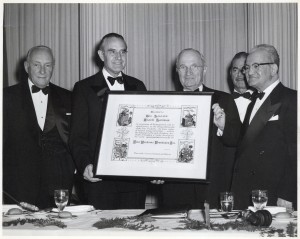 Above: Charles H. Silver, Governor Averell Harriman, President Harry Truman and others at a ceremony in honor of Harriman.
Above: Charles H. Silver, Governor Averell Harriman, President Harry Truman and others at a ceremony in honor of Harriman.
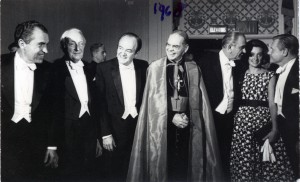 Above: Richard Nixon, Charles H. Silver, Hubert Humphrey, Terence Cardinal Cooke, President Lyndon Johnson, Margaretta “Happy” Rockefeller and Governor Nelson Rockefeller at the 1968 Al Smith Dinner.
Above: Richard Nixon, Charles H. Silver, Hubert Humphrey, Terence Cardinal Cooke, President Lyndon Johnson, Margaretta “Happy” Rockefeller and Governor Nelson Rockefeller at the 1968 Al Smith Dinner.
In addition to his medical and political interests, Silver was a strong advocate of public education and served for six years as Chairman of the New York City Board of Education. The Silver collection in the Mount Sinai Archives includes photographs of Silver with every U.S. President from Truman to Carter, two of which are presented here. No full-length biography of Silver has yet been written, but his eventful career is an important part of the story of New York City in the twentieth century.
Mar 18, 2016
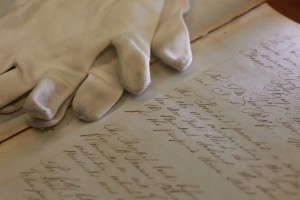 The Mount Sinai Archives is very happy to announce the unveiling of our new website. The new main page has gathered together under easy drop-down sections all of the information that was formerly embedded in text and hard to find. (We also really like the images that adorn the tops of the pages.) Our site now matches the style of our institutional web presence and, most importantly, provides much better visibility to our electronic resources. We have gathered onto the Digital Collections page a link to our digital repository, DSpace, a link to our image database, as well as a link to our digitized AV collection. Soon we will be updating the main pages of those programs as well, and we hope over the course of this year to be able to add a site for our oral history collection, which dates back to the 1960’s and features interviews with Mount Sinai physicians and leaders. Also of note is that on the Historical Resources page, we have gathered together links to digitized versions of histories relating to Mount Sinai, its staff and departments.
The Mount Sinai Archives is very happy to announce the unveiling of our new website. The new main page has gathered together under easy drop-down sections all of the information that was formerly embedded in text and hard to find. (We also really like the images that adorn the tops of the pages.) Our site now matches the style of our institutional web presence and, most importantly, provides much better visibility to our electronic resources. We have gathered onto the Digital Collections page a link to our digital repository, DSpace, a link to our image database, as well as a link to our digitized AV collection. Soon we will be updating the main pages of those programs as well, and we hope over the course of this year to be able to add a site for our oral history collection, which dates back to the 1960’s and features interviews with Mount Sinai physicians and leaders. Also of note is that on the Historical Resources page, we have gathered together links to digitized versions of histories relating to Mount Sinai, its staff and departments.
Please, check out our new website, and let us know if you have any comments or questions. We can be reached at MSarchives@mssm.edu.
[Edit: As of Summer 2022, the Archives no longer uses DSpace.]
Mar 8, 2016
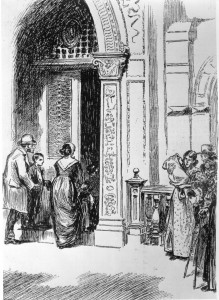
The entry to the Mount Sinai dispensary building where Dr. Welt served as chief of a pediatric clinic. This building on East 67th Street opened in 1890. In 1904 Dr. Welt moved with the clinic to the corner of Madison Avenue and 100th Street.
In honor of International Women’s Day, celebrated on March 8th, the Mount Sinai Archives wants to highlight a woman who is not remembered today, but who made a big impact on The Mount Sinai Hospital, Sara Welt Kakels, MD. Dr. Welt (1860-1943) was born in Czernowitz, Bukovina. She was one of four sisters, three of whom became physicians and the fourth a chemist. Sara Welt received her medical degree from the University of Zurich in 1885 and moved to New York City shortly thereafter to be with her sister, Dr. Rosa Welt Strauss, an ophthalmologist who also taught at The Mount Sinai Hospital School of Nursing.
In 1887, Dr. Welt was appointed to replace Mary Putnam Jacobi as one of the four heads of the Pediatrics clinics at the Hospital. She remained in charge of the clinic while she built a private practice in the community. In 1922 Sara Welt was the first woman to be appointed to the rank of Adjunct Pediatrician at Mount Sinai. She stepped down from active service in 1926 but remained closely affiliated with the Pediatrics Department until her death in 1943, at which time she bequeathed nearly $1,000,000 to Mount Sinai to establish the Sara Welt Memorial Fund, which established the Welt Fellowship program for young physicians who needed financial help, and also provided support of the Pediatric Clinic.
Dr. Welt married Moses S. Kakels, MD, a surgeon at the Mount Sinai clinics but primarily affiliated with Lebanon Hospital. Dr. Welt was very involved in teaching. She held appointments at the Women’s Medical College of the New York Infirmary, where she was an Instructor in the Practice of Medicine. She also lectured at The Mount Sinai Training School for Nurses on Anatomy and Physiology. She was an active member of The New York Academy of Medicine, as well as the New York Pathological Society. She had a pioneering interest in pediatric gynecology, and published over 20 articles on this and other topics.
When she died in 1943, the American Jewish Yearbook noted her final benevolence:
WELT-KAKELS, SARA (MRS. MOSES S. KAKELS), pediatrician Mt. Sinai Hosp., New York, N. Y., (d. Dec. 26, 1943), bequeathed to N. Y. Academy of Medicine $100,000 for aid of sick and needy physicians, $10,000 for lectureship by a pediatrician, and $20,000 for books and literature for library; $20,000 to Lebanon Hosp. for fellowship in surgery in honor of her husband; $10,000 to Hampton (Va.) Normal Agricultural Institute for establishment of four scholarships; and residuary estate, valued at $874,222, to Mt. Sinai Hosp., to set up “The Sara Welt Memorial Fund” ” and establish six traveling fellowships; reptd Feb. 6, 1946.
Sara Welt Fellows continued at The Mount Sinai Hospital for decades. Her support of these young doctors allowed her to touch the lives of thousands of patients.
Feb 24, 2016
A recent blog post from the History of Medicine Division of the National Library of Medicine (NLM) celebrates the wonderful resource in the history of medicine that is PubMed Central. Best known as a source of current, full-text biomedical articles, PubMed Central also includes the contents of medical journals dating back to 1809. NLM notes that there are now over 3.8 million total items available in PubMed Central.

A word cloud created by the National Library of Medicine showing the frequency of medical subject terms used to describe articles in PubMed Central.
The earliest article that mentions Mount Sinai dates to 1871 and the earliest article found that was written by a Mount Sinai physician was “On the Surgical Dissemination of Cancer” by Arpad G. Gerster, then Director of the Department of Surgery. Gerster was the first to suggest that cancer might be spread by surgical procedure.
Read the NLM blog post and then play around in PubMed Central. You are sure to find something of interest there.
Feb 4, 2016
In honor of Valentine’s Day, the Mount Sinai Archives looks at Mount Sinai’s ties to one of the most romantic movies of all time, “Love Story.” Yes, that 1970 classic tear-jerker that made the phrase, “Love means never having to say you’re sorry” a cultural phenomenon. It was a meme before memes were a thing.
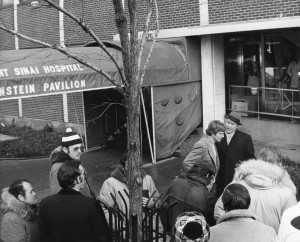
Filming “Love Story” outside of the Klingenstein Pavilion on 5th Avenue, c1969.
So, what role did Mount Sinai play in the movie? As you know (come on, the movie is 45 years old, there are no spoiler alerts), Jenny, played by Ali McGraw, meets and marries Oliver (Ryan O’Neal) while at Harvard and then falls ill and spends her final days – where else? – at The Mount Sinai Hospital Klingenstein Pavilion. There is a tense and touching scene at the end of the movie, after Oliver exits KP out onto 5th Avenue, between Ryan O’Neal and Ray Milland, who played his father.
Think this is old news? Just a few days ago, the Huffington Post ran a piece about how the two co-stars, McGraw and O’Neal, had put in an appearance at Harvard. Apparently, “Love Story” also means never having to say good-bye.
Jan 27, 2016
The Mount Sinai Archives has mounted its latest quarterly exhibit in the Annenberg elevator lobby. This season’s exhibit covers the history of the former Continuum Health Partners hospitals that are now part of the Mount Sinai Health System: Beth Israel Medical Center (now Mount Sinai Beth Israel), St. Luke’s Hospital (now Mount Sinai St. Luke’s), Roosevelt Hospital (now Mount Sinai West) and the New York Eye and Ear Infirmary (now the New York Eye and Ear Infirmary of Mount Sinai.)
 The combined histories of the former Continuum hospitals cover a significant portion of the history of medicine in New York City. The New York Eye and Ear Infirmary, founded in 1820, is the oldest specialty hospital in the United States and the oldest institution in the present Mount Sinai Health System. St. Luke’s Hospital, which opened its doors to patients in 1858, was the creation of a prominent clergyman, and Roosevelt Hospital was founded in 1868 with a bequest from a member of the distinguished New York family that later produced two U.S. Presidents. The service areas of these two hospitals, which merged in 1979, together encompass much of Manhattan’s West Side. Beth Israel, established on the Lower East Side in 1889 to provide care to impoverished Jewish immigrants, has a long tradition of community-focused medical care, including the nation’s largest nonprofit methadone treatment program.
The combined histories of the former Continuum hospitals cover a significant portion of the history of medicine in New York City. The New York Eye and Ear Infirmary, founded in 1820, is the oldest specialty hospital in the United States and the oldest institution in the present Mount Sinai Health System. St. Luke’s Hospital, which opened its doors to patients in 1858, was the creation of a prominent clergyman, and Roosevelt Hospital was founded in 1868 with a bequest from a member of the distinguished New York family that later produced two U.S. Presidents. The service areas of these two hospitals, which merged in 1979, together encompass much of Manhattan’s West Side. Beth Israel, established on the Lower East Side in 1889 to provide care to impoverished Jewish immigrants, has a long tradition of community-focused medical care, including the nation’s largest nonprofit methadone treatment program.
The exhibit will remain on display until the spring and contains numerous historic photographs and documents from the various hospitals, including an original nineteenth century minute book from the records of the Beth Israel Medical Center.
Pictured: Beth Israel Medical Center’s Linsky Pavilion as depicted in a 1964 anniversary volume.
Jan 20, 2016
In the first half of the 20th century, Mount Sinai was apparently full of song. The School of Nursing students sang every morning before classes and, of course, had an alma mater song for their school. The Mount Sinai Hospital had no medical school yet, but the active alumni association had festive annual meetings filled with songs and skits and inside jokes. While much of that material is not suitable for re-publication, the 1921 meeting of the Associated Alumni of The Mount Sinai Hospital did produce what they called an Alumni Song, with words written by Dr. L.M. Lyons and music by Dr. S. Samuels. This serious piece expressed their love of Mount Sinai and the many memories they formed during their training. Note that the song refers exclusively to the male alumni. This was because there were very few female alumnae. After a promising start in 1872, women house staff had been banned by the Trustees from 1911-1922. It was not until 1932 that women alumnae were first invited to the annual Alumni dinners.
Here is the Alumni Song from 1921:
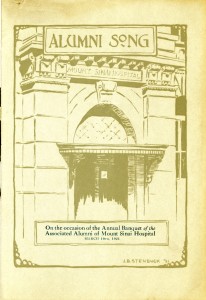
Cover of Alumni Song showing the main entrance to the Hospital on 100th Street.
Years ago on Sinai’s mount great Moses stood in awe,
And from the hands of God himself received our word and law,
To commemorate this famous deed some noble men with vision
Have built a hospital to stand with just and wise provision.
Humble at birth it’s slowly grown to fair most in our land
It’s sons unite to sing it’s praise and tell its story grand.
Chorus: Oh, Sinai, Mount Sinai, we venerate your name,
As loyal sons we loudly boast and proudly spread your fame
We tell each deed with fulsome meed of honor and of praise
We’ll ne’er forget the princely debt we owe to Sinai days.
As passing days go piling up and year grows after year,
We’ll turn a page in mem’ry’s book to one we hold most dear,
Again we’ll see our old time friends, as we knew them long ago,
Once more we’ll walk thru Sinai’s wards with faces all aglow.
Time shall drop the heavy load he’s laid upon each heart
And once again our voices joined, the old song we shall start.
Chorus: Oh, Sinai, Mount Sinai, we venerate your name,
As loyal sons we loudly boast and proudly spread your fame
We tell each deed with fulsome meed of honor and of praise
We’ll ne’er forget the princely debt we owe to Sinai days.
Dec 31, 2015
Every New Year brings expectations of new beginnings: new projects, new historical resources, and new historical insights we never imagined. We are sure 2016 will be no different, so what might we expect?
In 2016, the Mount Sinai Archives will become the official repository of the historical collections documenting the long histories of St. Luke’s and Roosevelt Hospitals. These will be transferred to Mount Sinai in the spring, and work will begin to catalog and make the content known and available to the public.
As noted in a previous blog, in February or March we will roll out a new, much improved website. This will provide much better access to our archival material, including a page featuring our always expanding digital collections. One piece of that is our audio-visual collection, and that will grow again soon as we process another batch of recently digitized tapes.
In 2016 we also hope to begin a long anticipated project to make available some of the Mount Sinai oral history collection. This includes interviews with Mount Sinai personalities, primarily physicians, as well as taped events, meetings, grand rounds presentations, investitures, and history of medicine at Mount Sinai lectures. This is a complex project to make the sound available and link it to transcripts where they exist, but we hope that 2016 will be the year that this process begins.
So, Happy New Year to you, and our best wishes for a fun and productive 2016.
Dec 9, 2015
The staff of the Mount Sinai Archives is hard at work pulling together text and images for a new Archives website to replace our existing 1999 era, fully Y2K compliant web pages. This has meant reviewing the current content, editing it where needed and trying to find the perfect images that are wide and not tall, and that will get across the theme of each page. Should the pictures be old and classic looking to show that we care for historical material? Or should they be all modern and techie to show our efforts to move our collection to the digital age? And what about the information itself? Which sections deserve their own pages, and which can be handled in a drop-down box?
All of these are questions we are working through right now. We will submit our first draft to the Mount Sinai web team next week, and then it will be up to them to design it into a coherent, eye catching whole. Watch for our new website in February or early March of 2016. The one thing we are certain of: the new website will be a big improvement over our current site!

Hmm, would this make a good website photo?











